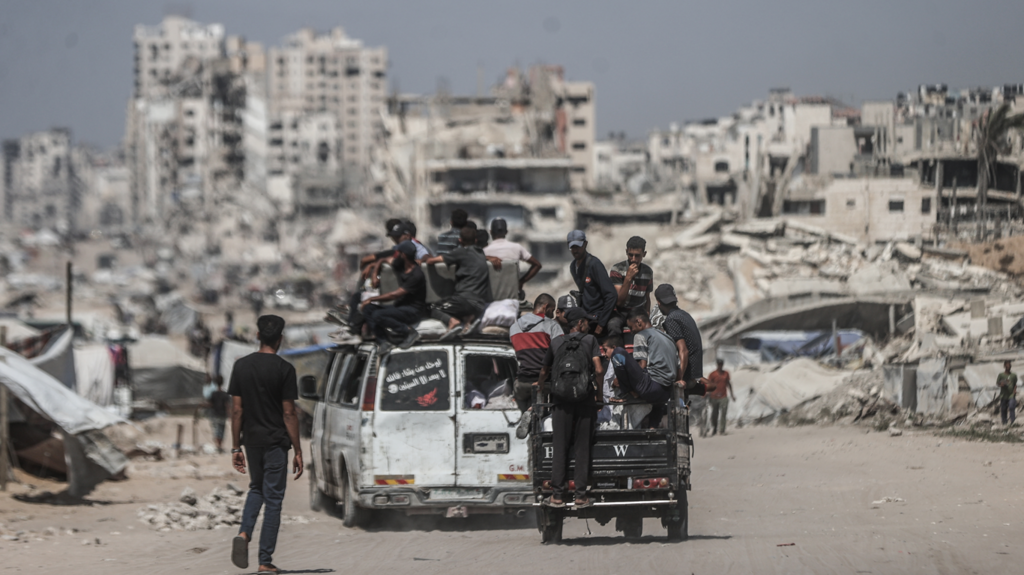Former British Prime Minister Tony Blair participated in a White House meeting with US President Donald Trump to discuss strategies for post-war Gaza, the BBC has confirmed.
Middle East envoy Steve Witkoff indicated that the US is developing a “very comprehensive” plan regarding “the next day” following the conflict. However, specific details of the meeting remain undisclosed.
Following his departure from office in 2007, Blair served as a Middle East envoy for several years, concentrating on fostering economic development in Palestinian territories and establishing conditions conducive to a two-state solution.
Conversely, when questioned by reporters about the prospect of a Palestinian state, Israeli Foreign Minister Gideon Saar asserted that such a state would not be established.
The White House meeting occurred amidst escalating tensions, as the Israeli military warned Palestinians that the evacuation of Gaza City was “inevitable” in preparation for an impending offensive.
Witnesses reported that Israeli tanks advanced into a new sector of the city overnight, resulting in the destruction of homes and the displacement of additional residents.
Recent Israeli advances have already prompted thousands to relocate, primarily within Gaza City, which continues to house approximately one million Palestinians.
Earlier in August, Israel announced its intention to occupy the entire Gaza Strip, including Gaza City, which it designated as Hamas’s last stronghold.
The UN and non-governmental organizations have cautioned that an Israeli offensive in Gaza City, where famine was declared last week, would have dire humanitarian consequences.
In a Tuesday interview with Fox News, Steve Witkoff expressed his belief that the conflict in Gaza could be resolved within the next four months.
“We’re going to settle this one way or another, certainly before the end of this year,” he stated.
When asked about a plan for governing post-war Gaza, he said: “It’s a very comprehensive plan we’re putting together on the next day that I think many people are going to… see how robust it is and how it’s how well meaning it is, and it reflects President Trump’s humanitarian motives here.”
The White House affirmed: “President Trump has been clear that he wants the war to end, and he wants peace and prosperity for everyone in the region.”
Specific details of the post-war Gaza proposals under consideration have not been disclosed. However, in February, Trump suggested the possibility of permanently relocating Gazans to neighboring countries, with the US assuming control of the territory to transform it into “the Riviera of the Middle East.”
The Axios website reported that Trump’s son-in-law and former senior adviser, Jared Kushner, was also present at the meeting.
On the ground in Gaza City, tanks entered the northern Ibad al-Rahman district on Tuesday night, destroying several homes, witnesses told Reuters news agency.
“All of a sudden, we heard that the tanks pushed into Ibad al-Rahman, the sounds of explosions became louder and louder, and we saw people escaping towards our area,” Saad Abed said in a message from his home in Jala Street, about 1km (0.6 miles) away.
On Wednesday, the tanks reportedly retreated to Jabalia, an area further north where they have been operating.
Bombardment also continued in Gaza City’s Shejaiya, Zeitoun and Sabra districts.
The Israeli military said in a statement on Wednesday that its troops had engaged in combat in the Jabalia area and on the outskirts of Gaza City, adding that they had eliminated a “terrorist cell” and located a weapons storage facility.
In a post on X on Wednesday, the military’s Arabic spokesman Avichay Adraee said that “evacuating Gaza City is inevitable” and told residents to relocate to southern Gaza.
He said there was “empty space” and that each family making the move would “receive the most generous humanitarian aid”.
Last week, the UN and non-governmental organisations warned that forcing hundreds of thousands of people to evacuate Gaza City and head south was “a recipe for further disaster and could amount to forcible transfer”.
They also said the areas of the south where displaced residents were expected to move were “overcrowded and ill-equipped to sustain human survival at scale”.
Prime Minister Benjamin Netanyahu said Israel would conquer the entire Gaza Strip after indirect talks with Hamas on a ceasefire and hostage release deal broke down last month.
But he is facing both international and domestic pressure to not proceed with the offensive.
On Tuesday evening, tens of thousands of protesters gathered in Tel Aviv demanding a ceasefire deal to bring home the remaining Israeli hostages held by Hamas. Only 20 of the 50 hostages are believed to be alive.
Israel has not accepted the latest proposal from regional mediators for a 60-day truce and the return of around half of the hostages, saying it will now only agree to a comprehensive deal to bring back all the hostages and end the war on its terms.
The Israeli military launched a campaign in Gaza in response to the Hamas-led attack on southern Israel on 7 October 2023, in which about 1,200 people were killed and 251 others were taken hostage.
Almost 62,900 people have been killed in Gaza since then, according to the Hamas-run health ministry.
Most of Gaza’s population has also been repeatedly displaced; more than 90% of homes are estimated to be damaged or destroyed; and the healthcare, water, sanitation and hygiene systems have collapsed; and UN-backed global food security experts have confirmed that there is famine in the Gaza City area.
Palestinian journalists give the BBC first-hand accounts of the hardship and dangers they face while reporting on the war.
James Grote had been holding a banner reading “I oppose genocide, I support Palestine Action”.
An initial Israeli military report says the attack targeted a “Hamas camera” and identified “gaps” for further investigation.
In an exclusive interview with BBC Persian, a prisoner describes what happened when Israeli missiles tore through Iran’s most notorious jail.
BBC Verify analyses footage from the attack and its aftermath to piece together the timeline of events and what it reveals.

